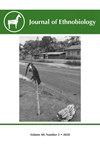穿山甲保护的人类层面:尼泊尔土著和当地知识、民族动物学用途以及农村社区加强穿山甲养护的意愿
IF 1.3
3区 社会学
Q1 ANTHROPOLOGY
引用次数: 3
摘要
摘要了解当地对野生动物的了解、当地用途以及当地人支持保护活动的意愿是制定野生动物保护战略的关键因素。我们对尼泊尔七个省不同生态区域的105个村庄的1017人进行了半结构化问卷调查。基于问卷得分,我们进行了广义线性混合建模(GLMM),以调查影响受访者对穿山甲知识的关键驱动因素。我们确定省份、种族、职业、性别和年龄组是影响当地穿山甲生态知识的有力预测因素。尼泊尔西部省份的受访者的知识得分明显低于东部和中部省份的受访者。同样,非土著群体、学生、女性和18-30岁人群的受访者对穿山甲的知识得分最低。据报道,尼泊尔各地都有关于穿山甲的一系列用途和信仰,48%的受访者认为穿山甲鳞片和肉被用于传统药物。大多数受访者(71.1%)愿意支持在当地保护穿山甲。我们的研究表明,提高认识计划、替代生计和为当地社区提供创收培训可能有助于加强尼泊尔穿山甲的长期保护。尼泊尔西部和全国各地需要加大对非土著社区、女性、年轻人和学生的努力。因此,这项研究提供了一个重要的基线,以帮助设计和执行有效的基于社区的穿山甲保护行动和管理决策。本文章由计算机程序翻译,如有差异,请以英文原文为准。
Human Dimensions of Pangolin Conservation: Indigenous and Local Knowledge, Ethnozoological Uses, and Willingness of Rural Communities to Enhance Pangolin Conservation in Nepal
Abstract. Understanding local knowledge about wildlife, local uses, and local people's willingness to support conservation activities are crucial factors in formulating wildlife conservation strategies. We conducted a semi-structured questionnaire survey of 1017 people from 105 villages located in different ecological regions across all seven Provinces of Nepal. We performed generalized linear mixed modeling (GLMM) to investigate the key drivers influencing respondents' knowledge about pangolins, based on a questionnaire score. We identified provinces, ethnicity, occupation, gender, and age group as strong predictors influencing local ecological knowledge about pangolins. The respondents from provinces in the western part of Nepal represented significantly lower knowledge scores than the respondents from the eastern and central provinces. Similarly, respondents belonging to non-Indigenous groups, students, females, and people aged between 18–30 years had the lowest knowledge scores about pangolins. A range of uses and beliefs about pangolins were reported across Nepal, and 48% of respondents believed that pangolin scales and meat were used for traditional medicines. The majority of respondents (71.1%) were willing to support pangolin conservation in their local areas. Our study suggests that awareness programs, alternative livelihood, and income-generating trainings for local communities could be helpful in enhancing the long-term conservation of pangolins in Nepal. Increased efforts are needed in western Nepal and across the country with non-Indigenous communities, females, young people, and students. Thus, this study offers an important baseline to help design and execute effective community-based conservation actions and management decisions for pangolin conservation.
求助全文
通过发布文献求助,成功后即可免费获取论文全文。
去求助
来源期刊

Journal of Ethnobiology
Social Sciences-Anthropology
CiteScore
4.80
自引率
3.40%
发文量
21
审稿时长
>12 weeks
期刊介绍:
JoE’s readership is as wide and diverse as ethnobiology itself, with readers spanning from both the natural and social sciences. Not surprisingly, a glance at the papers published in the Journal reveals the depth and breadth of topics, extending from studies in archaeology and the origins of agriculture, to folk classification systems, to food composition, plants, birds, mammals, fungi and everything in between.
Research areas published in JoE include but are not limited to neo- and paleo-ethnobiology, zooarchaeology, ethnobotany, ethnozoology, ethnopharmacology, ethnoecology, linguistic ethnobiology, human paleoecology, and many other related fields of study within anthropology and biology, such as taxonomy, conservation biology, ethnography, political ecology, and cognitive and cultural anthropology.
JoE does not limit itself to a single perspective, approach or discipline, but seeks to represent the full spectrum and wide diversity of the field of ethnobiology, including cognitive, symbolic, linguistic, ecological, and economic aspects of human interactions with our living world. Articles that significantly advance ethnobiological theory and/or methodology are particularly welcome, as well as studies bridging across disciplines and knowledge systems. JoE does not publish uncontextualized data such as species lists; appropriate submissions must elaborate on the ethnobiological context of findings.
 求助内容:
求助内容: 应助结果提醒方式:
应助结果提醒方式:


